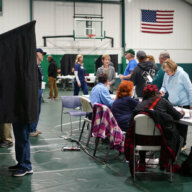Although a fixture on the streets of Center City, it’s unlikely that the trumpet-playing rollerblader will be performing at the Kimmel Center anytime soon. But when he showed up at the stage across the street, he was booked on the spot.
“When can you be here?” asked Marianne Bernstein, fishing through her bag for a pen.
Despite not being a terribly skilled trumpet player — and carrying a backpack that he claims can detect explosives and anger, assisting him in his peace-keeping rollerblading mission — the artist who prefers to go by “Nobody” is exactly who The Play House is looking for. A sparse 8-by-8 aluminum cube, it is part of “Not a Vacant Lot,” a Design Philadelphia project that has commandeered a formerly unoccupied lot at 313 S. Broad Street.
“We wanted to ask, ‘What can you do with these spaces? Who can use these spaces?’” says Bernstein, who once again teamed up with architect Daryn Edwards, her partner on 2009’s similar “Welcome House” installation at Love Park.
This weekend, The Play House will host everything from yoga classes to hip-hop concerts — in addition to evening video projections on a Spandex shell.
A reminder of the potential of the city’s 30,000-plus vacant lots, The Play House also asks us to take a second look at our fellow commuters, neighbors and rollerbladers.
“When you put something in a frame,” says Bernstein, “you see it differently.”
Mapping it out
Part Two of “Not a Vacant Lot” is an installation by Penn architecture grad students that maps out unused land in the city using PVC pipes.
“One of the things we’re emphasizing is the idea of instead of being reactive, being proactive; instead of just waiting for a job, getting out and knowing the neighborhood and making an impact, quite literally,” says architect Brian Phillips, who teaches the “Design for Impact” class. “There are lots of opportunities and urban spaces that can be put to use, and we’re thinking optimistically about it.”





























